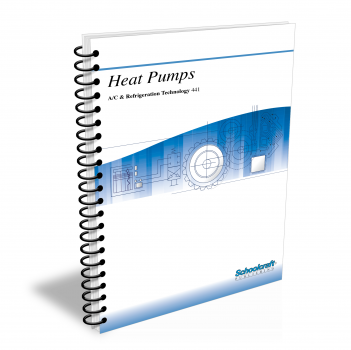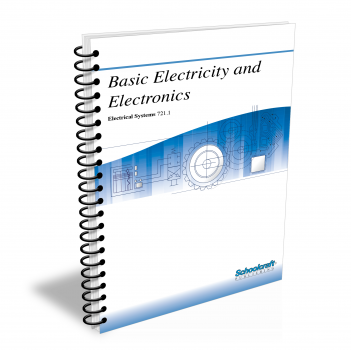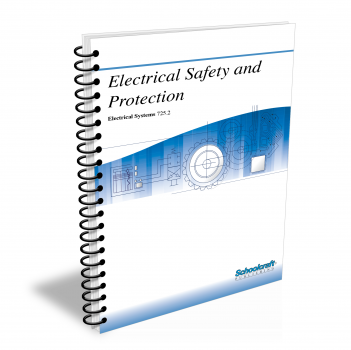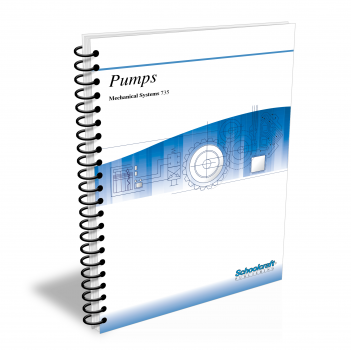Heat Pumps

Course Number: 441
The Heat Pumps textbook introduces the heat pump concept and related terminology. It covers water-to-water, water-to-air, ground-to-air, air-to-air, solar assisted, geothermal, dual-fuel, and split systems, as well as packaged units. The textbook defines balance points, coefficient of performance, energy efficiency ratio, and degree days. It also covers components, controls, installation, checkout, and startup.
Does your curriculum require additional topics not included in this textbook? Build a customized version of the Heat Pumps textbook below.
Recommended Contact Hours – 14
Preview a Chapter
Available Supporting Material
- Table of Contents
- My Custom Book
- Exam Copies
- Suggested Titles
Table of Contents
Chapter 1: Introduction to Heat Pumps
Topics: Heat pump operation and advantages; Cooling, heating, and defrost cycles; Balance points; Degree-days; Unit sizing; Operating costs
Learning Objectives:
- Explain how a heat pump differs from standard air-conditioning equipment.
- List the benefits of heat pump systems.
- Describe the heating, cooling, and defrost heat pump cycles.
- Define degree-day.
- List considerations in sizing heat pumps.
Chapter 2: Heat Pump Systems
Topics: Water-to-water, water-to-air, ground-to-air, air-to-air, solar-assisted, geothermal, dual-fuel, and split systems; Packaged units
Learning Objectives:
- Compare the operation of water-to-water and water-to-air heat pump systems.
- Compare the operation of ground-to-air and air-to-air heat pump systems.
- Describe the operation of solar-assisted heat pump systems.
- Describe the operation of geothermal heat pump systems.
- Describe the operation of dual-fuel heat pump systems.
- Discuss the differences in configuration and installation of split and packaged heat pump units.
Chapter 3: Balance Points and Cost of Operation
Topics: Determining balance points; Supplemental heating; Performance ratings; Efficiency ratings; Operating costs; Cost estimation
Learning Objectives:
- Determine heat pump system balance points and explain their relationship to system capacity.
- Discuss the use and control of supplemental heat.
- Discuss ARI single-point and seasonal heating and cooling ratings for heat pump equipment.
- Explain how several common variables affect heat pump operating costs.
- Describe how to use the heating degree-day, cooling degree-day, and bin methods of estimating heat pump system energy use.
- Describe common problems of heat pump systems in the heating mode.
Chapter 4: Heat Pump Components
Topics: Accumulators; Indoor and outdoor coils; Compressors; Reversing and check valves; Heat exchangers; Filter-driers, Thermostats
Learning Objectives:
- Explain why heat pump systems include an accumulator.
- Describe the indoor and outdoor coils, indoor air handling components, and various metering (flow-control) devices.
- Briefly discuss the requirements of reciprocating and scroll compressor operation as used in heat pump systems.
- Discuss the use and operation of the reversing valve and check valves in heat pump systems.
- Explain the functions of the equalizer tank, heat exchanger, and filter-driers in heat pump systems.
- Briefly describe indoor and outdoor controls and popular defrost control systems.
Chapter 5: Heat Pump Controls
Topics: Defrost and pressure controls; Heat sequencers; Emergency heat relay; Starting components; Lockout relays; Overload protectors
Learning Objectives:
- Describe the operation of the pressure differential and temperature differential defrost methods.
- Compare the advantages and disadvantages of the timed defrost and time-and-temperature defrost methods.
- Compare the construction and operation of electromechanical and solid-state defrost controls.
- Explain the functions of pressure controls, heat sequencers, and the emergency heat relay in heat pump systems.
- Describe typical starting and lockout devices used on heat pumps and explain why systems include transformers, contactors, and overload protectors.
Chapter 6: Heat Pump Installation
Topics: Outdoor and indoor units; Air distribution system; Refrigerant lines; Condensate drain; Electrical system; Packaged heat pumps
Learning Objectives:
- Discuss considerations in selecting the best location for outdoor unit installation.
- Discuss considerations in selecting the best location for indoor unit installation.
- Describe installation practices that help the air distribution system fulfill its purpose.
- Discuss procedures for installing refrigerant lines and primary and auxiliary drain lines.
- Discuss the requirements for installing electrical wiring.
- Describe additional requirements for installing a packaged heat pump unit.
Chapter 7: Heat Pump Checkout and Startup
Topics: Leak testing; Charging; Insulation; Electrical system, connections; Miscellaneous checks
Learning Objectives:
- Describe basic checkout procedures for the compressor crankcase heater, air distribution system, and all heat pump mountings.
- Describe basic steps in leak testing and charging a heat pump unit and discuss basic requirements for post-installation checkout of heat pump insulation and piping.
- Describe both the general post-installation checkout of the electrical system and tests to check specific electrical connections.
- Explain how to check the operation of the system thermostat, outdoor thermostats, and defrost controls.
- Name ways to increase blower output and explain why operator instructions are important.
Add Chapters to Your Custom Book
Select Chapter(s):
- Chapter 1: Introduction to Heat Pumps
- Chapter 2: Heat Pump Systems
- Chapter 3: Balance Points and Cost of Operation
- Chapter 4: Heat Pump Components
- Chapter 5: Heat Pump Controls
- Chapter 6: Heat Pump Installation
- Chapter 7: Heat Pump Checkout and Startup
My Custom Book
Create a custom book that contains only the training content that your students need to succeed
Our topics cover a broad and diverse spectrum of subject matter, from reading blueprints to electrical schematics, measurement to rigging and safety, material handling to welding, and everything in between! Choose only the lessons that meet your specific curriculum requirements.
Request Exam Copies
Exam Copies
Ready to see a copy of our textbooks? After selecting which textbooks you’d like to review for your course, you can submit your request by either logging in or creating an account so we know where to ship your exam copies. A representative from Schoolcraft will contact you to confirm and finish processing your request.
Exam copies are always free and yours to keep.
Selected Exam Copies
none selected
* Maximum of five copies can be ordered



